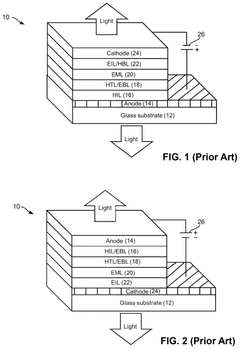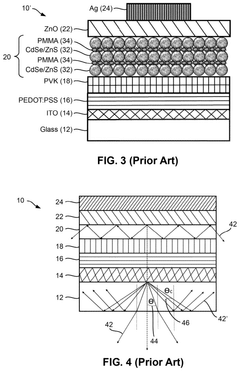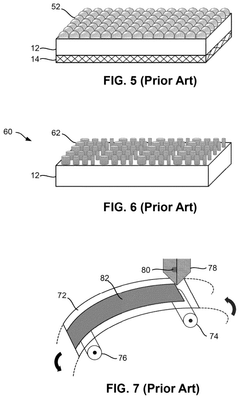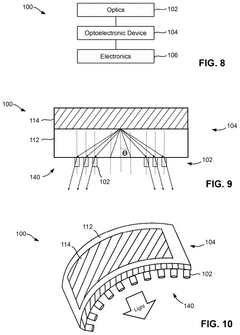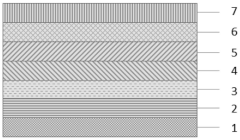How to Implement QLED Displays for Collaborative Spaces?
JUN 19, 20259 MIN READ
Generate Your Research Report Instantly with AI Agent
Patsnap Eureka helps you evaluate technical feasibility & market potential.
QLED Display Evolution
QLED display technology has undergone significant evolution since its inception, driven by the demand for higher quality, more energy-efficient displays in various applications, including collaborative spaces. The journey of QLED displays began with the development of quantum dots, nanoscale semiconductor particles that emit light when excited by an electric current.
In the early stages, researchers focused on improving the color gamut and brightness of QLED displays. The first generation of QLED displays utilized a film of quantum dots placed in front of a blue LED backlight, which resulted in enhanced color reproduction compared to traditional LCD displays. However, these early implementations faced challenges in terms of efficiency and longevity.
As the technology progressed, manufacturers developed methods to integrate quantum dots directly into the display structure, leading to the creation of true QLED displays. This advancement allowed for better control over light emission and improved energy efficiency. The integration of quantum dots into the pixel structure itself marked a significant milestone in QLED evolution, enabling displays to achieve deeper blacks and more vibrant colors.
The next phase of QLED development focused on enhancing the stability and durability of quantum dots. Researchers worked on developing protective coatings and encapsulation techniques to prevent degradation of the quantum dots, thereby extending the lifespan of QLED displays. This improvement was crucial for the adoption of QLED technology in collaborative spaces, where displays are often used for extended periods.
Recent advancements in QLED technology have centered on improving the viewing angles and reducing power consumption. Manufacturers have experimented with different quantum dot materials and structures to achieve wider viewing angles without compromising color accuracy. Additionally, efforts have been made to optimize the energy efficiency of QLED displays, making them more suitable for large-scale implementations in collaborative environments.
The evolution of QLED displays has also seen a shift towards more environmentally friendly production methods. Researchers have explored alternatives to cadmium-based quantum dots, developing materials that offer similar performance while reducing the environmental impact of manufacturing processes.
As QLED technology continues to mature, we are witnessing the emergence of flexible and transparent QLED displays. These innovations open up new possibilities for integrating displays into collaborative spaces, allowing for more creative and immersive environments. The ongoing research in this area promises to deliver even more advanced QLED solutions tailored for collaborative applications in the near future.
In the early stages, researchers focused on improving the color gamut and brightness of QLED displays. The first generation of QLED displays utilized a film of quantum dots placed in front of a blue LED backlight, which resulted in enhanced color reproduction compared to traditional LCD displays. However, these early implementations faced challenges in terms of efficiency and longevity.
As the technology progressed, manufacturers developed methods to integrate quantum dots directly into the display structure, leading to the creation of true QLED displays. This advancement allowed for better control over light emission and improved energy efficiency. The integration of quantum dots into the pixel structure itself marked a significant milestone in QLED evolution, enabling displays to achieve deeper blacks and more vibrant colors.
The next phase of QLED development focused on enhancing the stability and durability of quantum dots. Researchers worked on developing protective coatings and encapsulation techniques to prevent degradation of the quantum dots, thereby extending the lifespan of QLED displays. This improvement was crucial for the adoption of QLED technology in collaborative spaces, where displays are often used for extended periods.
Recent advancements in QLED technology have centered on improving the viewing angles and reducing power consumption. Manufacturers have experimented with different quantum dot materials and structures to achieve wider viewing angles without compromising color accuracy. Additionally, efforts have been made to optimize the energy efficiency of QLED displays, making them more suitable for large-scale implementations in collaborative environments.
The evolution of QLED displays has also seen a shift towards more environmentally friendly production methods. Researchers have explored alternatives to cadmium-based quantum dots, developing materials that offer similar performance while reducing the environmental impact of manufacturing processes.
As QLED technology continues to mature, we are witnessing the emergence of flexible and transparent QLED displays. These innovations open up new possibilities for integrating displays into collaborative spaces, allowing for more creative and immersive environments. The ongoing research in this area promises to deliver even more advanced QLED solutions tailored for collaborative applications in the near future.
Collaborative Space Needs
The implementation of QLED displays in collaborative spaces addresses several key market needs and trends in modern work environments. As organizations increasingly prioritize teamwork and cross-functional collaboration, there is a growing demand for advanced display technologies that can enhance communication, visualization, and interaction within shared workspaces.
One primary need is for high-quality, large-format displays that can accurately render complex visual information. QLED technology offers superior color reproduction, brightness, and contrast compared to traditional LCD displays, making it ideal for presenting detailed data, designs, and multimedia content in group settings. This improved visual fidelity is crucial for industries such as architecture, engineering, and creative design, where precise color representation and fine detail are essential.
Another significant market requirement is for displays that support seamless integration with various devices and collaboration tools. QLED displays can be equipped with advanced connectivity options, allowing multiple users to share content from different sources simultaneously. This capability aligns with the trend towards bring-your-own-device (BYOD) policies and the need for flexible, technology-agnostic collaboration solutions.
Energy efficiency and longevity are also key considerations for collaborative spaces. QLED displays typically consume less power than comparable OLED or LED-backlit LCD screens, potentially reducing operational costs for businesses. Additionally, their resistance to image retention and longer lifespan make them a more sustainable choice for high-usage environments like meeting rooms and innovation centers.
The market is also showing increased interest in displays that can adapt to different collaborative scenarios. QLED technology's ability to support modular and customizable display configurations allows for the creation of immersive environments that can be tailored to specific collaborative needs, from small huddle spaces to large-scale presentation areas.
As remote and hybrid work models become more prevalent, there is a growing need for display solutions that can bridge the gap between in-person and virtual collaboration. QLED displays, with their high resolution and color accuracy, can provide a more lifelike representation of remote participants and shared content, enhancing the overall quality of hybrid meetings and reducing the sense of disconnect between on-site and remote team members.
Lastly, there is a market trend towards creating more engaging and interactive collaborative spaces. QLED displays can be integrated with touch and gesture recognition technologies, enabling more intuitive and hands-on interaction with digital content. This aligns with the shift towards more dynamic and participatory meeting formats, where attendees can actively contribute to and manipulate shared information in real-time.
One primary need is for high-quality, large-format displays that can accurately render complex visual information. QLED technology offers superior color reproduction, brightness, and contrast compared to traditional LCD displays, making it ideal for presenting detailed data, designs, and multimedia content in group settings. This improved visual fidelity is crucial for industries such as architecture, engineering, and creative design, where precise color representation and fine detail are essential.
Another significant market requirement is for displays that support seamless integration with various devices and collaboration tools. QLED displays can be equipped with advanced connectivity options, allowing multiple users to share content from different sources simultaneously. This capability aligns with the trend towards bring-your-own-device (BYOD) policies and the need for flexible, technology-agnostic collaboration solutions.
Energy efficiency and longevity are also key considerations for collaborative spaces. QLED displays typically consume less power than comparable OLED or LED-backlit LCD screens, potentially reducing operational costs for businesses. Additionally, their resistance to image retention and longer lifespan make them a more sustainable choice for high-usage environments like meeting rooms and innovation centers.
The market is also showing increased interest in displays that can adapt to different collaborative scenarios. QLED technology's ability to support modular and customizable display configurations allows for the creation of immersive environments that can be tailored to specific collaborative needs, from small huddle spaces to large-scale presentation areas.
As remote and hybrid work models become more prevalent, there is a growing need for display solutions that can bridge the gap between in-person and virtual collaboration. QLED displays, with their high resolution and color accuracy, can provide a more lifelike representation of remote participants and shared content, enhancing the overall quality of hybrid meetings and reducing the sense of disconnect between on-site and remote team members.
Lastly, there is a market trend towards creating more engaging and interactive collaborative spaces. QLED displays can be integrated with touch and gesture recognition technologies, enabling more intuitive and hands-on interaction with digital content. This aligns with the shift towards more dynamic and participatory meeting formats, where attendees can actively contribute to and manipulate shared information in real-time.
QLED Tech Challenges
The implementation of QLED displays for collaborative spaces faces several significant technical challenges. One of the primary hurdles is achieving uniform brightness and color consistency across large-scale displays. As collaborative spaces often require expansive screens, maintaining consistent image quality becomes increasingly difficult due to variations in quantum dot performance and light distribution.
Another major challenge lies in enhancing the durability and longevity of QLED displays in high-usage environments. Collaborative spaces typically involve frequent interactions, potentially exposing the displays to physical contact, environmental factors, and extended operating hours. Developing robust encapsulation techniques to protect quantum dots from degradation and ensuring the longevity of the display under these conditions remains a critical technical obstacle.
Power efficiency presents a further challenge, particularly for large-scale implementations. While QLEDs offer improved energy efficiency compared to some other display technologies, optimizing power consumption for expansive collaborative displays without compromising brightness and image quality is an ongoing area of research. This challenge is compounded by the need for displays that can operate for extended periods in shared spaces.
The integration of touch and interactive functionalities into QLED displays poses additional technical difficulties. Implementing responsive and accurate touch sensing without affecting the display's visual performance or increasing the overall thickness of the panel is a complex task. Moreover, ensuring compatibility between the quantum dot layer and touch sensor components while maintaining the display's optical properties requires innovative engineering solutions.
Heat management is another critical challenge in QLED display implementation. The performance and lifespan of quantum dots can be significantly affected by temperature fluctuations. Developing effective thermal management systems that can dissipate heat efficiently, especially in large-format displays for collaborative spaces, is essential for maintaining consistent performance and preventing premature degradation of the quantum dot material.
Lastly, the challenge of cost-effective production at scale remains a significant hurdle. While QLED technology offers several advantages, manufacturing large-format displays for collaborative spaces at competitive price points requires further advancements in production processes and materials. Balancing the cost of high-quality quantum dots, sophisticated backlighting systems, and advanced control electronics with the need for affordability in commercial and educational settings is an ongoing challenge for manufacturers and researchers in the field.
Another major challenge lies in enhancing the durability and longevity of QLED displays in high-usage environments. Collaborative spaces typically involve frequent interactions, potentially exposing the displays to physical contact, environmental factors, and extended operating hours. Developing robust encapsulation techniques to protect quantum dots from degradation and ensuring the longevity of the display under these conditions remains a critical technical obstacle.
Power efficiency presents a further challenge, particularly for large-scale implementations. While QLEDs offer improved energy efficiency compared to some other display technologies, optimizing power consumption for expansive collaborative displays without compromising brightness and image quality is an ongoing area of research. This challenge is compounded by the need for displays that can operate for extended periods in shared spaces.
The integration of touch and interactive functionalities into QLED displays poses additional technical difficulties. Implementing responsive and accurate touch sensing without affecting the display's visual performance or increasing the overall thickness of the panel is a complex task. Moreover, ensuring compatibility between the quantum dot layer and touch sensor components while maintaining the display's optical properties requires innovative engineering solutions.
Heat management is another critical challenge in QLED display implementation. The performance and lifespan of quantum dots can be significantly affected by temperature fluctuations. Developing effective thermal management systems that can dissipate heat efficiently, especially in large-format displays for collaborative spaces, is essential for maintaining consistent performance and preventing premature degradation of the quantum dot material.
Lastly, the challenge of cost-effective production at scale remains a significant hurdle. While QLED technology offers several advantages, manufacturing large-format displays for collaborative spaces at competitive price points requires further advancements in production processes and materials. Balancing the cost of high-quality quantum dots, sophisticated backlighting systems, and advanced control electronics with the need for affordability in commercial and educational settings is an ongoing challenge for manufacturers and researchers in the field.
QLED Implementation
01 Quantum dot light-emitting diode structure
QLED displays utilize a structure incorporating quantum dots as the light-emitting material. This structure typically includes layers such as a substrate, electrodes, quantum dot layer, and charge transport layers. The quantum dots are engineered to emit specific colors when electrically excited, providing high color purity and efficiency.- Quantum dot light-emitting diode structure: QLED displays utilize a structure incorporating quantum dots as the light-emitting material. This structure typically includes layers such as a substrate, electrodes, quantum dot layer, and charge transport layers. The quantum dots are engineered to emit specific colors when electrically excited, providing high color purity and efficiency.
- Color conversion and enhancement techniques: Various methods are employed to improve color performance in QLED displays. These include using color filters, optimizing quantum dot compositions, and implementing color conversion layers. Such techniques aim to enhance color gamut, improve color accuracy, and increase overall display efficiency.
- Manufacturing processes for QLED displays: Specialized manufacturing techniques are developed for QLED displays, including methods for depositing quantum dot layers, patterning electrodes, and integrating various display components. These processes focus on improving yield, reducing costs, and enhancing the overall quality and performance of QLED displays.
- Driving and control systems for QLED displays: Advanced driving and control systems are designed to optimize the performance of QLED displays. These include circuits for precise current control, methods for compensating for variations in quantum dot characteristics, and algorithms for enhancing image quality and reducing power consumption.
- Integration of QLED technology with other display innovations: QLED technology is combined with other display innovations to create advanced display solutions. This includes integration with flexible or transparent substrates, incorporation into micro-LED displays, and development of hybrid QLED-OLED systems. These integrations aim to expand the application range and enhance the capabilities of QLED displays.
02 Color conversion layer using quantum dots
Some QLED display designs use quantum dots as a color conversion layer rather than direct light emitters. In this approach, blue LEDs are used as a backlight, and quantum dots convert the blue light to red and green, creating a full-color display. This method can improve color gamut and energy efficiency compared to traditional LCD displays.Expand Specific Solutions03 Quantum dot synthesis and composition
The performance of QLED displays heavily depends on the properties of the quantum dots used. Research focuses on developing new quantum dot compositions, improving synthesis methods, and enhancing the stability and efficiency of these nanoparticles. This includes exploring various core-shell structures and doping techniques to optimize optical properties.Expand Specific Solutions04 Encapsulation and protection of quantum dots
Protecting quantum dots from environmental factors such as moisture and oxygen is crucial for the longevity and performance of QLED displays. Various encapsulation techniques and materials are developed to enhance the stability of quantum dots while maintaining their optical properties. This includes the use of barrier films, sealants, and specialized packaging methods.Expand Specific Solutions05 Driving and control circuits for QLED displays
Efficient driving and control of QLED displays require specialized electronic circuits. These circuits manage power delivery, pixel addressing, and color calibration to ensure optimal display performance. Advanced driving schemes are developed to enhance brightness, reduce power consumption, and improve overall image quality in QLED displays.Expand Specific Solutions
QLED Industry Leaders
The implementation of QLED displays for collaborative spaces is in a growth phase, with increasing market size and technological advancements. The industry is experiencing rapid development as companies recognize the potential of QLED technology in enhancing collaborative environments. Key players like BOE Technology Group, Apple, and Huawei are driving innovation, while specialized firms such as SMART Technologies ULC focus on tailored solutions. The technology's maturity is progressing, with companies like LG Electronics and Sharp Display Technology Corp. making significant strides in QLED display quality and efficiency. As the market expands, we're seeing a diverse ecosystem of manufacturers, from established tech giants to emerging players like Xian NovaStar Tech and Guangzhou Shizhen Information Technology, contributing to the evolution of QLED displays for collaborative applications.
BOE Technology Group Co., Ltd.
Technical Solution: BOE has developed advanced QLED display technology for collaborative spaces, utilizing quantum dot materials to enhance color gamut and brightness. Their solution incorporates a high-resolution panel with wide viewing angles, ideal for large meeting rooms. The displays feature touch-sensitive capabilities and seamless integration with various collaboration software platforms. BOE's QLED displays also include eye-protection technology to reduce eye strain during long meetings.
Strengths: Superior color performance, high brightness, and wide viewing angles. Weaknesses: Higher cost compared to traditional LCD displays, potential for image retention.
Apple, Inc.
Technical Solution: Apple's approach to QLED displays for collaborative spaces focuses on integrating their ecosystem seamlessly. Their solution combines high-resolution QLED panels with proprietary software for enhanced collaboration. The displays feature True Tone technology for automatic color adjustment based on ambient light, and support for Apple Pencil for precise input. Apple's collaborative QLED displays also incorporate spatial audio technology for immersive video conferencing experiences.
Strengths: Seamless integration with Apple ecosystem, high-quality display technology. Weaknesses: Limited compatibility with non-Apple devices, potentially higher cost.
QLED Core Innovations
Integrated optoelectronic devices for lighting and display applications
PatentPendingUS20240341118A1
Innovation
- Incorporation of metasurfaces with two-dimensional arrays of nanostructures into the light-emitting devices to reduce photon reflection, control light direction, and manipulate emission profiles, combined with machine-learning methods for optimizing light patterns and using flexible substrates like hybrid silver nanowires and carbon nanotubes for improved conductivity and stability.
QLED device and preparation method and application thereof
PatentPendingCN117479569A
Innovation
- Cross-linked hole transport materials and p-type doping materials are used as raw materials for the hole injection layer to improve the injection efficiency of the hole injection layer and balance electrons and holes, thereby improving the luminous efficiency of the QLED device.
QLED Energy Efficiency
QLED displays have gained significant attention in collaborative spaces due to their superior energy efficiency compared to traditional display technologies. This efficiency stems from the unique properties of quantum dots, which can convert light with high precision and minimal energy loss. In QLED displays, quantum dots are excited by a blue LED backlight, emitting pure colors without the need for color filters, resulting in reduced power consumption.
The energy efficiency of QLED displays is further enhanced by their ability to achieve high brightness levels with lower power input. This is particularly beneficial in collaborative spaces where ambient light conditions may vary. The displays can maintain optimal visibility without excessive energy expenditure, contributing to overall power savings in the workspace.
Another factor contributing to QLED energy efficiency is the improved color gamut coverage. By producing more accurate and vibrant colors, QLEDs can deliver high-quality visuals at lower brightness settings, further reducing power consumption. This is especially advantageous in collaborative environments where color accuracy is crucial for design work or data visualization.
QLED displays also benefit from advanced local dimming technologies, which allow for precise control of backlight zones. This feature enables the display to selectively dim or turn off areas of the screen that are displaying dark content, significantly reducing power consumption in scenes with high contrast ratios. In collaborative spaces where content may vary from presentations to video conferencing, this adaptive brightness control contributes to overall energy savings.
The longevity of QLED displays further enhances their energy efficiency profile. With a longer lifespan compared to some other display technologies, QLEDs reduce the frequency of replacements, thereby decreasing the overall energy footprint associated with manufacturing and disposal of display units. This aspect is particularly relevant for collaborative spaces that require continuous operation and aim to minimize long-term environmental impact.
As QLED technology continues to evolve, ongoing research focuses on further improving energy efficiency. This includes developing quantum dots with higher quantum yield, optimizing backlight designs, and implementing more sophisticated power management algorithms. These advancements promise to make QLED displays an increasingly attractive option for energy-conscious collaborative spaces seeking to balance visual performance with sustainability goals.
The energy efficiency of QLED displays is further enhanced by their ability to achieve high brightness levels with lower power input. This is particularly beneficial in collaborative spaces where ambient light conditions may vary. The displays can maintain optimal visibility without excessive energy expenditure, contributing to overall power savings in the workspace.
Another factor contributing to QLED energy efficiency is the improved color gamut coverage. By producing more accurate and vibrant colors, QLEDs can deliver high-quality visuals at lower brightness settings, further reducing power consumption. This is especially advantageous in collaborative environments where color accuracy is crucial for design work or data visualization.
QLED displays also benefit from advanced local dimming technologies, which allow for precise control of backlight zones. This feature enables the display to selectively dim or turn off areas of the screen that are displaying dark content, significantly reducing power consumption in scenes with high contrast ratios. In collaborative spaces where content may vary from presentations to video conferencing, this adaptive brightness control contributes to overall energy savings.
The longevity of QLED displays further enhances their energy efficiency profile. With a longer lifespan compared to some other display technologies, QLEDs reduce the frequency of replacements, thereby decreasing the overall energy footprint associated with manufacturing and disposal of display units. This aspect is particularly relevant for collaborative spaces that require continuous operation and aim to minimize long-term environmental impact.
As QLED technology continues to evolve, ongoing research focuses on further improving energy efficiency. This includes developing quantum dots with higher quantum yield, optimizing backlight designs, and implementing more sophisticated power management algorithms. These advancements promise to make QLED displays an increasingly attractive option for energy-conscious collaborative spaces seeking to balance visual performance with sustainability goals.
QLED Interactivity
QLED displays in collaborative spaces offer unprecedented opportunities for interactive and immersive experiences. The interactivity of QLED technology enables multi-touch capabilities, gesture recognition, and seamless integration with various input devices. This enhanced interactivity allows for more engaging and productive collaborative sessions, where multiple users can simultaneously interact with the display.
One of the key features of QLED interactivity is its low latency response time. This ensures that user inputs are reflected on the screen almost instantaneously, creating a more natural and fluid interaction experience. The high refresh rates of QLED displays further contribute to this smooth interaction, making them ideal for fast-paced collaborative environments where real-time feedback is crucial.
QLED displays also support advanced touch sensitivity, allowing for precise input even with light touches. This feature is particularly beneficial in collaborative spaces where users may need to make intricate annotations or manipulate detailed visual elements. The ability to detect multiple touch points simultaneously enables multi-user interaction, fostering a truly collaborative environment where team members can work together on the same display surface.
Furthermore, QLED technology's compatibility with various input methods enhances its versatility in collaborative spaces. Beyond touch input, these displays can integrate with stylus pens for more precise drawing and writing, as well as with gesture recognition systems for touchless control. This flexibility allows users to choose the most comfortable and efficient input method for their specific tasks.
The high contrast ratio and wide color gamut of QLED displays also play a significant role in interactivity. These features ensure that visual feedback is clear and vibrant, even in brightly lit environments common in many collaborative spaces. This high visibility enhances the overall interactive experience, making it easier for users to perceive and respond to on-screen elements.
Implementing QLED displays in collaborative spaces also opens up possibilities for augmented reality (AR) applications. The displays can serve as a canvas for overlaying digital information onto the physical environment, creating interactive experiences that blend the digital and physical worlds. This capability can be particularly useful for design reviews, data visualization, and interactive presentations in collaborative settings.
One of the key features of QLED interactivity is its low latency response time. This ensures that user inputs are reflected on the screen almost instantaneously, creating a more natural and fluid interaction experience. The high refresh rates of QLED displays further contribute to this smooth interaction, making them ideal for fast-paced collaborative environments where real-time feedback is crucial.
QLED displays also support advanced touch sensitivity, allowing for precise input even with light touches. This feature is particularly beneficial in collaborative spaces where users may need to make intricate annotations or manipulate detailed visual elements. The ability to detect multiple touch points simultaneously enables multi-user interaction, fostering a truly collaborative environment where team members can work together on the same display surface.
Furthermore, QLED technology's compatibility with various input methods enhances its versatility in collaborative spaces. Beyond touch input, these displays can integrate with stylus pens for more precise drawing and writing, as well as with gesture recognition systems for touchless control. This flexibility allows users to choose the most comfortable and efficient input method for their specific tasks.
The high contrast ratio and wide color gamut of QLED displays also play a significant role in interactivity. These features ensure that visual feedback is clear and vibrant, even in brightly lit environments common in many collaborative spaces. This high visibility enhances the overall interactive experience, making it easier for users to perceive and respond to on-screen elements.
Implementing QLED displays in collaborative spaces also opens up possibilities for augmented reality (AR) applications. The displays can serve as a canvas for overlaying digital information onto the physical environment, creating interactive experiences that blend the digital and physical worlds. This capability can be particularly useful for design reviews, data visualization, and interactive presentations in collaborative settings.
Unlock deeper insights with Patsnap Eureka Quick Research — get a full tech report to explore trends and direct your research. Try now!
Generate Your Research Report Instantly with AI Agent
Supercharge your innovation with Patsnap Eureka AI Agent Platform!
